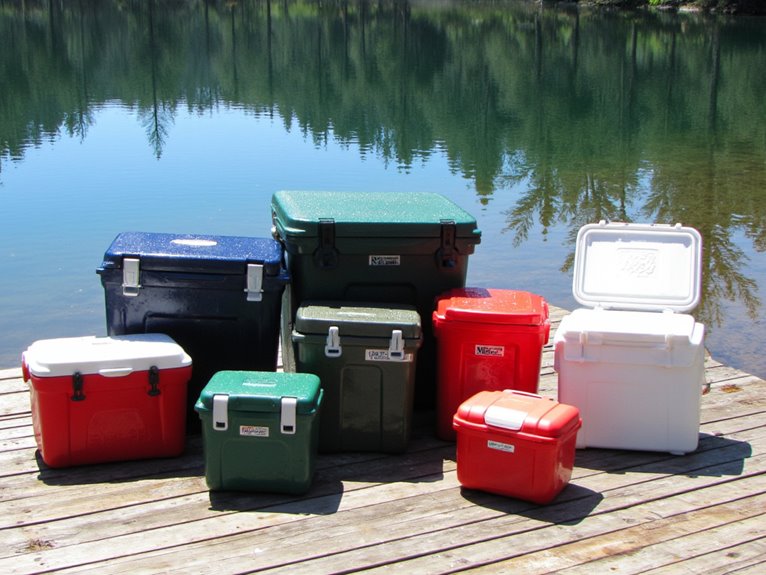Can Butane Go Bad?
Butane fuel is not immune to degradation, and its quality and shelf life can be compromised by various factors. Chemical composition, manufacturing process, and handling practices can affect its shelf life. Improper storage, exposure to heat, light, and moisture can accelerate degradation, leading to a decline in product quality and performance. Ignoring signs of deterioration, such as sediment, rust, or corrosion, can lead to equipment damage, safety risks, and decreased performance. To guarantee safe and efficient use, understanding the complex dynamics that affect butane's shelf life is crucial, and taking the next step in exploring these factors can help maintain safe and peak use.
We are supported by our audience. When you purchase through links on our site, we may earn an affiliate commission, at no extra cost for you. Learn more. Last update on 25th November 2025 / Images from Amazon Product Advertising API.
Signs of Deteriorating Butane Fuel
Over time, butane fuel can exhibit distinct signs of deterioration, including the presence of sediment, rust, or corrosion in the tank or canister, which can ultimately affect its performance and shelf life.
These signs may not be immediately apparent, but they can profoundly impact the fuel's quality and usability.
Sediment, for instance, can clog fuel lines and engines, while rust and corrosion can weaken the container and compromise the fuel's integrity.
As butane fuel degrades, it may also exhibit a change in color, odor, or consistency, indicating that it is no longer suitable for use.
Recognizing these signs is essential to ensuring the safe and effective use of butane fuel.
Factors Affecting Butane Shelf Life
As butane fuel's quality and usability are compromised by signs of deterioration, understanding the factors that influence its shelf life is vital to maintaining its performance and safety.
Butane's shelf life is primarily affected by its chemical composition, manufacturing process, and handling practices.
Impurities, contaminants, and additives can alter its chemical properties, leading to degradation.
Additionally, the type of container, valve, and seal used can impact the fuel's stability.
Moreover, exposure to environmental factors such as heat, light, and moisture can accelerate degradation.
Storage Conditions and Quality
Proper storage conditions play a critical role in maintaining the quality and shelf life of butane fuel, as even slight deviations from ideal storage conditions can compromise its performance and safety.
Butane is highly sensitive to temperature, humidity, and light exposure, making it essential to store it in a cool, dry place away from direct sunlight.
Containers should be tightly sealed to prevent moisture and air from entering, and stored upright to prevent leakage.
Additionally, butane should be kept away from heat sources, open flames, and sparks to minimize the risk of ignition.
Effects of Contamination on Butane
Contamination can substantially impact the quality and performance of butane, and understanding the effects of impurities on this fuel is crucial.
The presence of contaminants can lead to various issues, including corrosion of metal parts, moisture absorption, and impurities within the can itself.
These factors can compromise the integrity of the butane, resulting in decreased performance, safety risks, and potential damage to equipment.
Impurities in the Can
Impurities in the can, whether introduced during manufacturing or storage, can substantially compromise the quality and performance of butane, rendering it unreliable for various applications.
Contaminants can originate from the canning process, handling, or exposure to environmental factors. Moisture, in particular, can lead to the formation of corrosive compounds, affecting the can's internal lining and the butane itself.
Additionally, particulate matter, such as dust or debris, can clog nozzles or valves, impeding the flow of gas. The presence of impurities can also alter the combustion properties of butane, making it unsuitable for use in devices like lighters, stoves, or camping equipment.
To maintain the quality of butane, the integrity of the canning process and storage conditions must be safeguarded. Proper quality control measures must be implemented to guarantee the purity of the butane.
Furthermore, rigorous testing protocols must be established to verify the quality of the final product.
Corrosion of Metal Parts
One of the most insidious consequences of contamination in butane is the corrosion of metal parts, which can lead to catastrophic failures in devices and equipment.
When impurities are present in the fuel, they can react with metal components, causing corrosion and degradation.
This can lead to a range of problems, including:
- Rust and corrosion of metal components, weakening their structural integrity.
- Leakage and seepage of fuel, resulting in safety hazards and environmental damage.
- Clogged fuel lines and injectors, reducing performance and efficiency.
- Premature wear and tear on moving parts, requiring costly repairs and maintenance.
The corrosion of metal parts is a critical concern in the context of butane contamination, and proactive steps must be taken to prevent it.
Moisture Absorption Effects
Moisture absorption, a pernicious consequence of butane contamination, can drastically alter the fuel's chemical composition and performance characteristics.
Water molecules can bond with butane, leading to the formation of impurities that compromise the fuel's energy density and stability.
This can result in decreased combustion efficiency, reduced engine performance, and increased emissions.
Additionally, moisture absorption can facilitate the growth of microorganisms, which can further degrade the fuel.
The effects of moisture absorption can be particularly pronounced in butane fuels with high water content, making it essential to maintain proper storage and handling practices to prevent contamination.
Butane Degradation Over Time
When examining the shelf life of butane, one must take into account the impact of time on its chemical composition.
Butane degradation over time is a critical factor, as it can lead to a decline in product quality and performance.
The rate of degradation is influenced by storage conditions, with improper storage accelerating the chemical breakdown of butane.
Storage Conditions Matter
Proper storage conditions play a crucial role in maintaining the quality and shelf life of butane, as exposure to heat, light, or oxygen can trigger degradation over time. To prevent degradation, it's essential to store butane in a controlled environment.
Some key storage conditions are:
Temperature: Store butane between 60°F and 80°F (15°C and 27°C) to prevent thermal degradation.
Humidity: Keep butane away from humid environments to prevent moisture absorption.
Light: Store butane in a dark or shaded area to prevent light-induced degradation.
Ventilation: Provide good ventilation to prevent oxygen buildup, which can accelerate degradation.
Proper storage conditions are essential for maintaining the quality and shelf life of butane.
Chemical Breakdown Occurs
Butane's molecular structure begins to unravel over time, triggering a gradual degradation that compromises its performance and quality.
This chemical breakdown is a natural process that occurs due to various factors, including oxidation, contamination, and exposure to heat, light, or moisture.
As butane degrades, its molecular bonds begin to break, leading to the formation of impurities and byproducts.
These impurities can affect the fuel's combustion characteristics, potentially causing issues with appliances and equipment.
In addition, degraded butane may not burn efficiently, resulting in reduced heat output, clogged burner tips, and increased emissions.
Understanding the chemical breakdown of butane is essential for maintaining peak performance, ensuring safety, and extending the lifespan of butane-powered devices.
Safety Risks of Old Butane
One of the most significant concerns associated with old butane is the increased risk of leakage, which can lead to fires, explosions, or asphyxiation.
This is because the canister's seals and valves may degrade over time, allowing the pressurized gas to escape.
Fire hazards: Leaking butane can ignite, causing fires or explosions.
Asphyxiation: In enclosed spaces, leaked butane can displace oxygen, leading to asphyxiation.
Explosions: Built-up butane gas can ignite, causing devastating explosions.
Property damage: Leaks can also cause property damage, resulting in costly repairs.
Proper Storage and Handling Tips
To minimize the risks associated with old butane, it is crucial to prioritize proper storage and handling practices to prevent leakage and promote safe use.
Store butane canisters in a cool, dry place, away from heat sources and open flames. Keep them upright to prevent leakage and make certain the valve is tightly closed.
Handle canisters with care, avoiding drops or impacts that could cause damage. Regularly inspect canisters for signs of rust, corrosion, or damage, and replace them if necessary.
Always follow the manufacturer's guidelines for storage and handling, and dispose of empty canisters responsibly.




